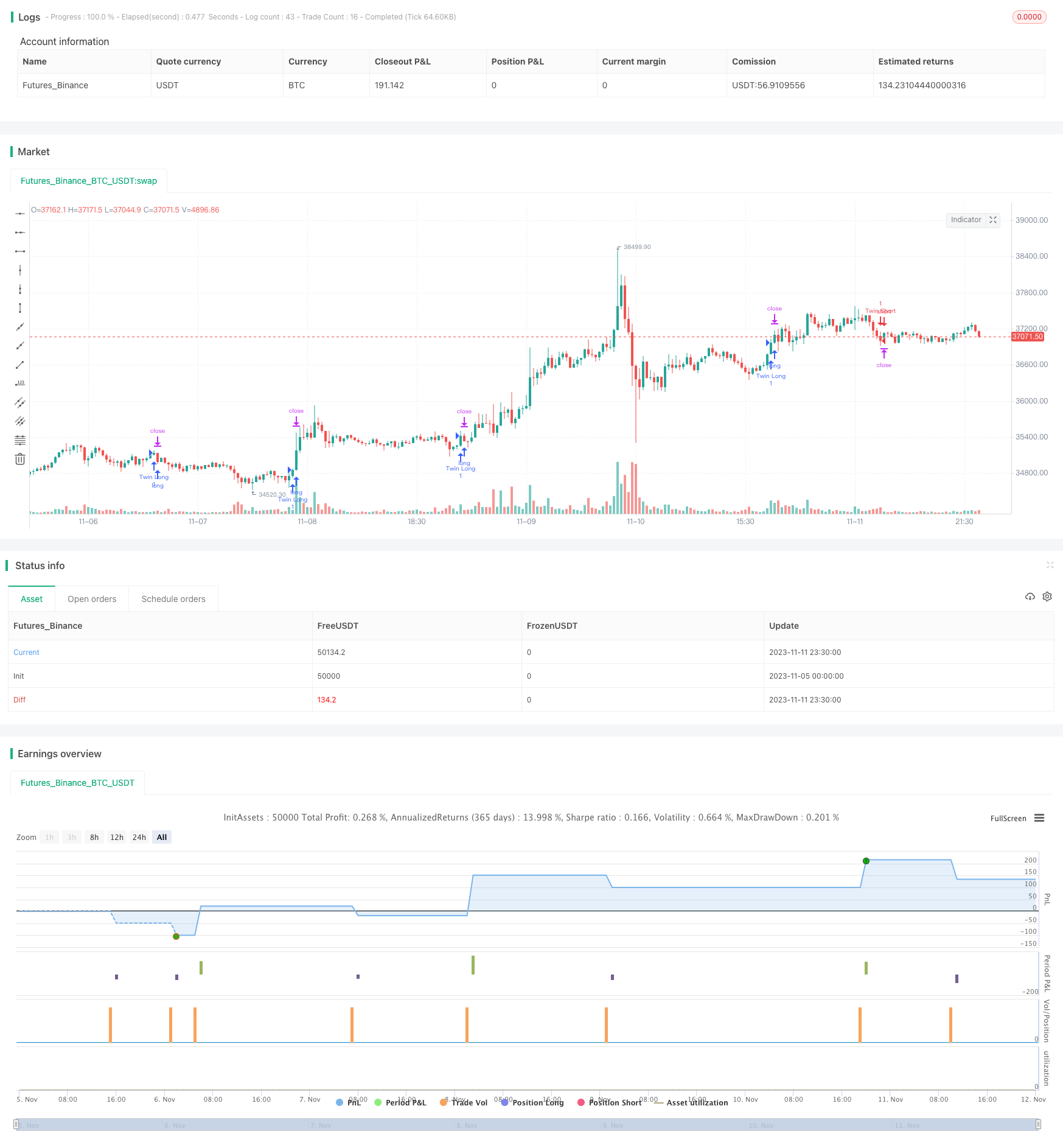
概述
双波震动过滤策略是一种基于价格波动性的交易策略。它利用两个不同参数设置的平均波动范围指标,结合价格与波动范围的关系,产生交易信号。该策略适用于比特币等具有高波动性的数字资产。
策略原理
该策略使用两个不同周期长度的平滑波动范围指标:快速波动范围指标(默认周期27)和慢速波动范围指标(默认周期55)。波动范围指标的计算公式是:当前周期价格波动幅度的指数移动平均乘以一个倍数(如1.6)。
双波震动过滤策略则是比较价格与两个波动范围指标的关系,判断目前是否处于一定幅度的震荡区间内。当价格突破该震荡区间时,产生交易信号。
具体来说,策略以中值线为基准,中值线为两个波动范围指标的平均值。当价格上方超过中值线一个快速波动范围时产生做多信号;当价格下方低于中值线一个快速波动范围时产生做空信号。
为了过滤误报,该策略还加入了一个条件:只有当价格与之前一个周期的价格走向一致时,才产生信号。例如,只有当价格上涨且超过中值线一个波动范围时,才产生做多信号。
总而言之,该策略利用双波动范围指标识别震荡区间,以价格突破震荡区间为信号,产生交易指令。同时加入价格方向过滤,以减少错误信号。
策略优势
双波震动过滤策略的优势有:
利用价格波动性特征,能适应比特币等高波动率资产。双波动范围指标能更准确定位价格震荡区间。
双波动范围指标包含不同时间长度。快速指标能捕捉短期突破机会,慢速指标考虑长期趋势。
加入价格方向过滤条件,可以减少因短期动荡造成的错误信号。
交易逻辑简单清晰,容易理解实现,适合量化交易。
策略风险
双波震动过滤策略也存在一些风险需要注意:
依赖波动率指标,在低波动市场中效果可能不佳。
波动范围参数需要针对不同品种调整优化,否则会错过交易机会或产生错误信号。
未考虑价格背离于波动率的情况。当波动率上升而价格没有对应涨幅时,可能发出错误信号。
在高波动环境中,止损点设定可能需要调整。过于激进的止损会频繁止损。
策略优化
该策略可从以下几个方面进行优化:
对波动范围参数进行测试和优化,找到不同品种不同周期的最优参数组合。
加入根据最近波动率动态调整止损位置的机制,优化止损策略。
增加基于价格与波动率背离的过滤条件,避免错误信号。
结合其他指标,如交易量变化,增加入场确定性。
测试并加入适合策略的止盈退出机制。
总结
双波震动过滤策略整体来说是一个针对高波动资产的有效交易策略。它正确利用价格波动特征,产生了简单清晰的交易逻辑。通过参数优化、风险管理等进一步完善,该策略可以成为量化交易体系中的一个有价值的组成部分。它也为我们提供了一个基于市场波动性特征进行算法交易的思路。
/*backtest
start: 2023-11-05 00:00:00
end: 2023-11-12 00:00:00
period: 30m
basePeriod: 15m
exchanges: [{"eid":"Futures_Binance","currency":"BTC_USDT"}]
*/
// This source code is subject to the terms of the Mozilla Public License 2.0 at https://mozilla.org/MPL/2.0/
// © colinmck, greenmask9
//@version=4
strategy(title="Twin Range Filter Algo", overlay=true)
source = input(defval=close, title="Source")
// Smooth Average Range
per1 = input(defval=27, minval=1, title="Fast period")
mult1 = input(defval=1.6, minval=0.1, title="Fast range")
per2 = input(defval=55, minval=1, title="Slow period")
mult2 = input(defval=2, minval=0.1, title="Slow range")
smoothrng(x, t, m) =>
wper = t * 2 - 1
avrng = ema(abs(x - x[1]), t)
smoothrng = ema(avrng, wper) * m
smoothrng
smrng1 = smoothrng(source, per1, mult1)
smrng2 = smoothrng(source, per2, mult2)
smrng = (smrng1 + smrng2) / 2
// Range Filter
rngfilt(x, r) =>
rngfilt = x
rngfilt := x > nz(rngfilt[1]) ? x - r < nz(rngfilt[1]) ? nz(rngfilt[1]) : x - r :
x + r > nz(rngfilt[1]) ? nz(rngfilt[1]) : x + r
rngfilt
filt = rngfilt(source, smrng)
upward = 0.0
upward := filt > filt[1] ? nz(upward[1]) + 1 : filt < filt[1] ? 0 : nz(upward[1])
downward = 0.0
downward := filt < filt[1] ? nz(downward[1]) + 1 : filt > filt[1] ? 0 : nz(downward[1])
hband = filt + smrng
lband = filt - smrng
longCond = bool(na)
shortCond = bool(na)
longCond := source > filt and source > source[1] and upward > 0 or source > filt and source < source[1] and upward > 0
shortCond := source < filt and source < source[1] and downward > 0 or source < filt and source > source[1] and downward > 0
CondIni = 0
CondIni := longCond ? 1 : shortCond ? -1 : CondIni[1]
long = longCond and CondIni[1] == -1
short = shortCond and CondIni[1] == 1
// Plotting
// Strategy
// From this part on, programmer is greenmaks9
//
Separator = input(title="Following conditions and backtest algorithm are added by @greenmask9 🎯, original script is written by @colinmck 👍. Read both of their's release notes for more info on how this script works.", type=input.bool, defval=false)
disabler = input(title="Disable greenmask9's ATR conditions", type=input.bool, defval=false)
//second
l2 = input(title="ATR1", defval=32, minval=1)
s2 = input(title="Smoothing", defval="SMA", options=["RMA", "SMA", "EMA", "WMA"])
atr2(source, l2) =>
if s2 == "SMA"
sma(source, l2)
else
if s2 == "RMA"
rma(source, l2)
else
if s2 == "EMA"
ema(source, l2)
else
wma(source, l2)
//third
l3 = input(title="ATR2", defval=64, minval=1)
s3 = input(title="Smoothing", defval="RMA", options=["RMA", "SMA", "EMA", "WMA"])
atr3(source, l3) =>
if s3 == "RMA"
rma(source, l3)
else
if s3 == "SMA"
sma(source, l3)
else
if s3 == "EMA"
ema(source, l3)
else
wma(source, l3)
atr20=atr2(tr(true), l2)
atr30=atr3(tr(true), l3)
strategy.initial_capital = 50000
ordersize=floor(strategy.initial_capital/close)
profit = input(title="Ticks profit", type=input.integer, defval=900)
stop = input(title="Ticks stoploss", type=input.integer, defval=300)
maxcandles_till_close = input(title="Time stoploss", type=input.integer, defval=17)
bull = long and (atr20<atr30 or disabler)
bear = short and (atr20<atr30 or disabler)
bullclock = barssince(bull)
bearclock = barssince(bear)
if (bull)
strategy.entry("Twin Long", strategy.long, ordersize)
strategy.exit("Exit", from_entry = "Twin Long", profit = profit, loss = stop)
if (bear)
strategy.entry("Twin Short", strategy.short, ordersize)
strategy.exit("Exit", from_entry = "Twin Short", profit = profit, loss = stop)
//time stoploss
strategy.close("Twin Long", when = bullclock == maxcandles_till_close, comment = "Timed out")
strategy.close("Twin Short", when = bearclock == maxcandles_till_close, comment = "Timed out")